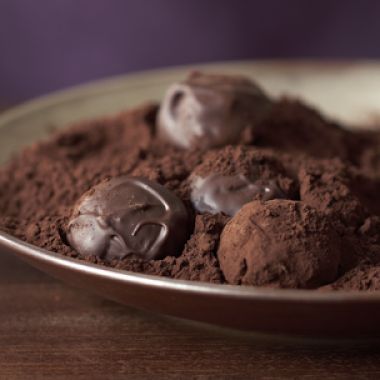
Many kinds of chocolate are created by adding ingredients such as sugar or milk to chocolate liquor. Some general variations and additions are described below.
Baking Chocolate
See Unsweetened Chocolate, below.
Bitter Chocolate
See Unsweetened Chocolate, below.
Bittersweet Chocolate
Bittersweet chocolate is made from chocolate liquor sweetened with sugar and blended with additional cocoa butter. This chocolate is at least 35% chocolate liquor, with sugar making up about 40% of its weight. In general, European dark chocolates are called bittersweet, while American dark chocolates are called semisweet. For everything but the most specialized confectionery, the two can be used interchangeably in baked goods, frostings, sauces and candies. Bittersweet chocolate also has devoted fans who eat it right out of the wrapper.
Chocolate Chips
These small droplets of semisweet, milk or white chocolate let you incorporate the confection evenly into batters or doughs, of which a favorite example is chocolate chip cookies. Although their slightly lower cocoa butter content helps them keep their shape when baked, chocolate chips also melt easily and evenly, eliminating the need to chop blocks or bars of chocolate for melting.
Cocoa Powder
Cocoa powder is made by removing nearly all the cocoa butter from chocolate liquor and then grinding it to an unsweetened powder. While less fatty than other chocolate, it still contains about 22% cocoa butter. Do not confuse this unsweetened powder with sweetened cocoa drink mixes.
Alkalized, or Dutch process, cocoa powder is treated with an alkali to make it milder and more soluble than nonalkalized cocoa powder. Nonalkalized, or natural, cocoa powder is lighter in color but bolder in flavor than the alkalized powder.
Both types of cocoa powder have their roles in baking and cooking, and one is not better than the other. Nonalkalized cocoa powder is always used for devil's food cake because when the mildly acidic cocoa powder reacts with the baking soda in the recipe, it gives the cake crumb its characteristic reddish hue. Use the kind of cocoa powder specified in the recipe. If none is specified, use either.
Couverture Chocolate
This high-quality dark chocolate is used for specialty candy making. Because of its relatively high percentage of cocoa butter, it melts smoothly, making it easier for enrobing, dipping and molding chocolate. When properly tempered and cooled, it forms a thin, glossy shell. You will find couverture chocolate in some specialty-food shops and in mail-order catalogs.
Dark Chocolate
This term describes any sweetened chocolate without milk solids, usually referring to bittersweet and semisweet chocolates.
Milk Chocolate
This familiar chocolate contains milk solids, cocoa butter and sugar. Milk chocolate is most often eaten out of hand in the form of a candy bar, although it appears in recipes from time to time. It should not be substituted for bittersweet or semisweet chocolate, except in the form of chips for chocolate chip cookies.
Plain Chocolate
In the United States, the term plain chocolate refers to unsweetened chocolate, while in Great Britain the term commonly refers to bittersweet chocolate. See Unsweetened Chocolate, below.
Semisweet Chocolate
This dark chocolate is at least 35% chocolate liquor. Semisweet chocolate is what Europeans call bittersweet; the terms are interchangeable.
Sweet Chocolate
Sweet chocolate is dark chocolate that is sweeter than semisweet but is not milk chocolate. It is an ingredient rarely called for in recipes, except for German chocolate cake, named for the chocolate's inventor.
Unsweetened Chocolate
Also called baking, plain or bitter chocolate, unsweetened chocolate is chocolate liquor that is refined but not sweetened. This product is used only for baking and cooking and never for eating out of hand.
White Chocolate
White chocolate is a mixture of cocoa butter, sugar and milk solids but no chocolate liquor. Some manufacturers market a product called confectionery coating, which is like white chocolate but contains vegetable fat instead of cocoa butter and is less expensive.
Adapted from Williams-Sonoma Kitchen Companion: The A to Z Guide to Everyday Cooking, Equipment and Ingredients (Time-Life Books, 2000)












